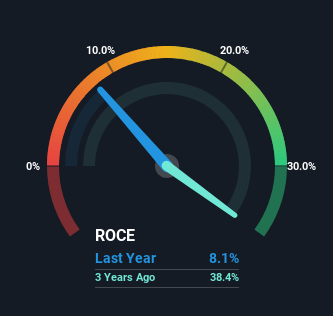- Saudi Arabia
- /
- Professional Services
- /
- SASE:1831
Investors Could Be Concerned With Maharah for Human Resources' (TADAWUL:1831) Returns On Capital
If you're looking for a multi-bagger, there's a few things to keep an eye out for. Firstly, we'll want to see a proven return on capital employed (ROCE) that is increasing, and secondly, an expanding base of capital employed. If you see this, it typically means it's a company with a great business model and plenty of profitable reinvestment opportunities. Having said that, from a first glance at Maharah for Human Resources (TADAWUL:1831) we aren't jumping out of our chairs at how returns are trending, but let's have a deeper look.
What Is Return On Capital Employed (ROCE)?
Just to clarify if you're unsure, ROCE is a metric for evaluating how much pre-tax income (in percentage terms) a company earns on the capital invested in its business. To calculate this metric for Maharah for Human Resources, this is the formula:
Return on Capital Employed = Earnings Before Interest and Tax (EBIT) ÷ (Total Assets - Current Liabilities)
0.081 = ر.س106m ÷ (ر.س1.8b - ر.س451m) (Based on the trailing twelve months to September 2023).
Thus, Maharah for Human Resources has an ROCE of 8.1%. In absolute terms, that's a low return and it also under-performs the Professional Services industry average of 13%.
See our latest analysis for Maharah for Human Resources

Above you can see how the current ROCE for Maharah for Human Resources compares to its prior returns on capital, but there's only so much you can tell from the past. If you'd like, you can check out the forecasts from the analysts covering Maharah for Human Resources for free.
What Does the ROCE Trend For Maharah for Human Resources Tell Us?
On the surface, the trend of ROCE at Maharah for Human Resources doesn't inspire confidence. Over the last five years, returns on capital have decreased to 8.1% from 47% five years ago. Although, given both revenue and the amount of assets employed in the business have increased, it could suggest the company is investing in growth, and the extra capital has led to a short-term reduction in ROCE. And if the increased capital generates additional returns, the business, and thus shareholders, will benefit in the long run.
On a side note, Maharah for Human Resources has done well to pay down its current liabilities to 26% of total assets. That could partly explain why the ROCE has dropped. What's more, this can reduce some aspects of risk to the business because now the company's suppliers or short-term creditors are funding less of its operations. Some would claim this reduces the business' efficiency at generating ROCE since it is now funding more of the operations with its own money.
Our Take On Maharah for Human Resources' ROCE
Even though returns on capital have fallen in the short term, we find it promising that revenue and capital employed have both increased for Maharah for Human Resources. And the stock has followed suit returning a meaningful 46% to shareholders over the last three years. So while investors seem to be recognizing these promising trends, we would look further into this stock to make sure the other metrics justify the positive view.
One final note, you should learn about the 3 warning signs we've spotted with Maharah for Human Resources (including 1 which is potentially serious) .
While Maharah for Human Resources isn't earning the highest return, check out this free list of companies that are earning high returns on equity with solid balance sheets.
New: Manage All Your Stock Portfolios in One Place
We've created the ultimate portfolio companion for stock investors, and it's free.
• Connect an unlimited number of Portfolios and see your total in one currency
• Be alerted to new Warning Signs or Risks via email or mobile
• Track the Fair Value of your stocks
Have feedback on this article? Concerned about the content? Get in touch with us directly. Alternatively, email editorial-team (at) simplywallst.com.
This article by Simply Wall St is general in nature. We provide commentary based on historical data and analyst forecasts only using an unbiased methodology and our articles are not intended to be financial advice. It does not constitute a recommendation to buy or sell any stock, and does not take account of your objectives, or your financial situation. We aim to bring you long-term focused analysis driven by fundamental data. Note that our analysis may not factor in the latest price-sensitive company announcements or qualitative material. Simply Wall St has no position in any stocks mentioned.
About SASE:1831
Maharah for Human Resources
Provides manpower services to public and private sectors in Saudi Arabia and the United Arab Emirates.
High growth potential with adequate balance sheet.
Similar Companies
Market Insights
Community Narratives



